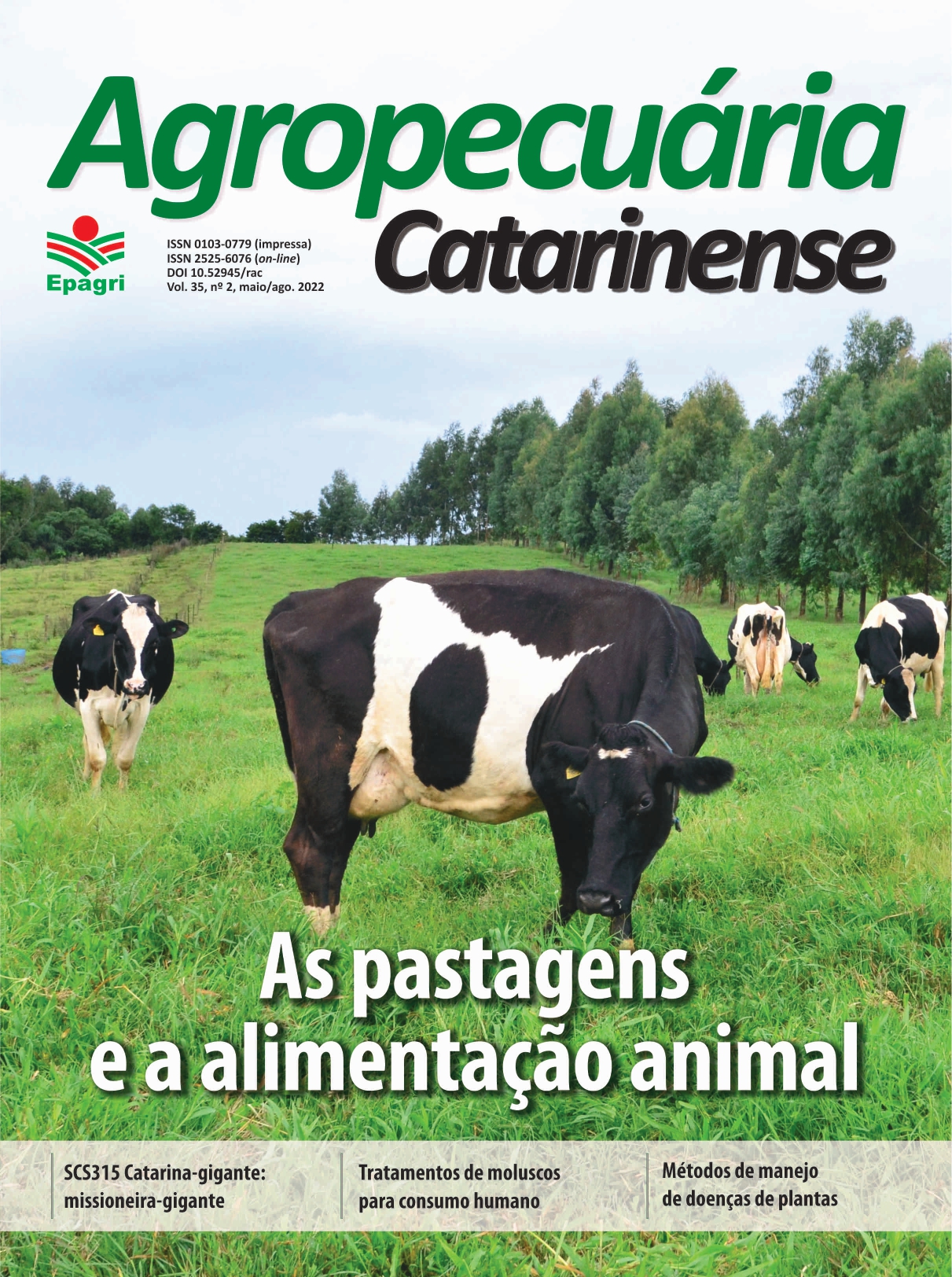Fusarium Head Blight and Deoxynivalenol: What is the relationship and how may fungicides help?
DOI:
https://doi.org/10.52945/rac.v35i2.1469Keywords:
DON, Fusarium graminearum, Mycotoxins, WheatAbstract
Fusarium Head Blight (FHB) disease, caused mainly by Fusarium gramineraum, is one of the most common in wheat. Besides causing yield reductions, it is also associated with the accumulation of mycotoxins in the kernels, especially deoxynivalenol (DON). This work was carried out in two harvest seasons and aimed at using different sowing dates, cultivars and fungicide applications to help in the increase of yield and kernel quality (decrease of DON contamination). The work was developed under a randomized block design. Weak correlations between FHB incidence, incidence of Fusarium in the kernels and DON were observed. Fungicides helped in the increase of yields and in the achievement of better hectoliter weight and weight of a thousand kernels, mainly in 2019 (more humid year). Fungicides are excellent tools to help achieving higher yields, however, its use must be carried out with caution not to favor mycotoxin biosynthesis and accumulation.
Metrics
References
BECK, H.E.; ZIMMERMANN, N.E.; MCVICAR, T.R.; VERGOPOLAN, N.; BERG, A.; WOOD, E.F. Present and future Köppen-Geiger climate classification maps at 1-km resolution. Scientific Data, v.5, 180214, 2018. DOI: https://doi.org/10.1038/sdata.2018.214.
BONFADA, E.B.; HONNEF, D.; FRIEDRICH, M.T.; BOLLER, W.; DEUNER, C.C. Performance of fungicides on the control of fusarium head blight (Triticum aestivum L.) and deoxynivalenol contamination in wheat grains. Summa Phytopathologica, v. 45, n. 4, p. 374–380, 2019. DOI: https://doi.org/10.1590/0100-5405/191941.
DRAZ, I.S.; ESMAIL, S.M.; ABOU-ZEID, M.A.E-H.; ESSA, T.A.E-M. Powdery mildew susceptibility of spring wheat cultivars as a major constraint on grain yield. Annals of Agricultural Sciences, v.64, n.1, p.39–45, 2019. DOI: https://doi.org/10.1016/j.aoas.2019.05.007.
DUCATTI, R.D.B.; WORDELL FILHO, J.A.; MAZARO, S. M. Deoxynivalenol biosynthesis and accumulation in wheat affected by carrageenan. Revista de Ciências Agroveterinárias, v.21, n.2, p.176–181, 2022. DOI: https://doi.org/10.5965/223811712122022176.
JI, F.; WU, J.; ZHAO, H.; XU, J.; SHI, J. Relationship pf deoxynivalenol content in grain, chaff, and straw with Fusarium head blight severity in wheat varieties with various levels of resistance. Toxins, v.7, p.728–742, 2015. DOI: https://doi.org/10.3390/toxins7030728.
LARGE, E.C. Growth stages in cereals illustration of the Feekes scale. Plant Pathology, v.3, n.4, p.128–129, 1954. DOI: https://doi.org/10.1111/j.1365-3059.1954.tb00716.x.
MARIN, S.; RAMOS, A.J.; CANO-SANCHO, G.; SANCHIS, V. Mycotoxins: Occurrence, toxicology, and exposure assessment. Food and Chemical Toxicology, v. 60, p. 218–237, 2013. DOI: https://doi.org/10.1016/j.fct.2013.07.047.
MCMULLEN, M.; BERGSTROM, G.; DE WOLF, E.; DILL-MACKY, R.; HERSHMAN, D.; SHANER, G.; VAN SANFORD, D. A Unified Effort to Fight and Enemy of Wheat and Barley: Fusarium Head Blight. Plant Disease, v. 96, n. 12, p. 1712–1728, 2012. DOI: https://doi.org/10.1094/PDIS-03-12-0291-FE.
MERHEJ, J.; BOUTIGNY, A.L.; PINSON-GADAIS, L.; RICHARD-FORGET, F.; BARREAU, C. Acidic pH as a determinant of TRI gene expression and trichothecene B biosynthesis in Fusarium graminearum. Food Additive & Contaminants – Part A, v. 27, p. 710–717, 2010. DOI: https://doi.org/10.1080/19440040903514531.
PINTON, P.; OSWALD, I.P. Effect of deoxynivalenol and other type B trichothecenes on the intestine: a review. Toxins, v.6, n.5, p.1615–1643, 2014. DOI: https://doi.org/10.3390/toxins6051615.
PONTE, E.M.D.; GARDA-BUFFON, J.; BADIALE-FURLONG, E. Deoxynivalenol and nivalenol in commercial wheat grain related to Fusarium Head Blight epidemics in southern Brazil. Food Chemistry, v.132, n.2, p.1087–1091, 2012. DOI: https://doi.org/10.1016/j.foodchem.2011.10.108.
PONTS, N. Mycotoxins are a component of Fusarium graminearum stress-response system. Frontiers in Microbiology, v.6, p.1–5, 2015. DOI: https:/doi.org/10.3389/fmicb.2015.01234.
RANDHAWA, M.S.; BHAVANI, S.; SINGH, P.K.; HUERTA-ESPINO, J.; SINGH, R.P. Disease Resistance in Wheat: Present Status and Future Prospects. In: WANI, S.H. (Ed.). Disease Resistance in Crop Plants. Switzerland: Springer, 2019. p. 61–81. DOI: https://doi.org/10.1007/978-3-030-20728-1_4.
REIS, E.M.; BOARETO, C.; DANELLI, A.L.D.; ZOLDAN, S.M. Anthesis, the infectious process and disease progress curves for fusarium head blight in wheat. Summa Phytopathologica, v. 42, n. 2, p. 134–139, 2016. DOI: https://doi.org/10.1590/0100-5405/2075.
STACK, R.W.; MCMULLEN, M.P. A visual scale to estimate severity of Fusarium head blight in wheat. NDSU Extension Service. North Dakota State University, 2011.
WEGULO, S.N. Factors Influencing Deoxynivalenol Accumulation in Small Grain Cereals. Toxins, v.4, n.11, p.1157–1180, 2012. DOI: https://doi.org/10.3390/toxins4111157.
Downloads
Published
How to Cite
Issue
Section
License
Copyright (c) 2022 João Américo Wordell Filho, Rafael Dal Bosco Ducatti, Cristiano Nunes Nesi

This work is licensed under a Creative Commons Attribution 4.0 International License.



